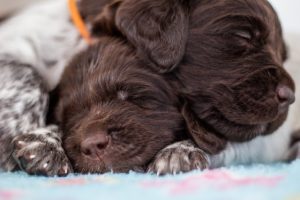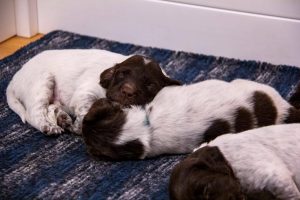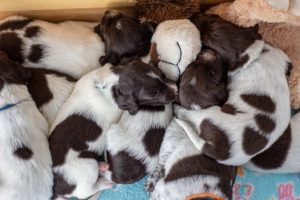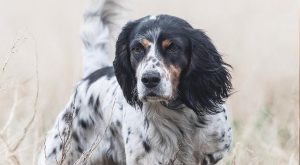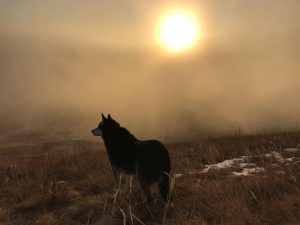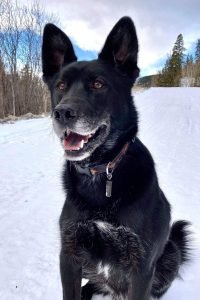Last summer, I promised Finn we’d take at least one out-of-province hunting trip annually. For our first trip, we hunted sage grouse in Montana. This year we got invited to come to Idaho, and we didn’t hesitate long.
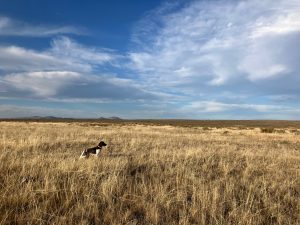
Day 1
The hotel in Great Falls looks a little tired, despite the ongoing renovations. Water drips from the parkade ceiling, cheap office furniture that was out of style thirty years ago piled up alongside the unmarked elevator door. The border crossing was uneventful, one twenty gauge side by side shotgun and two boxes of sixes, carried by a tired-looking old guy with a dog no cause for alarm.
We skip dinner, skip the beer, and turn in after a walk through a mostly deserted down town. I need to stop booking these cheap motels.
Day 2
We’re on the road early. In Butte we turn East, instead of following the direct route, taking the scenic backroads. Lewis and Clark, ghost towns, fly fishing shops, new housing developments. The tiny town of Ennis now has three large realtor offices. Descending from the Caribou-Targhee National Forest, we spill out onto the potato fields of Eastern Idaho. Traffic picks up closer to Idaho Falls, we miss an exit and add twenty miles to our trip. Another cheap motel, squeezed in between the highway and a series of silos. Their fans create a background hum all night, accentuated by the horns of the occasional train. Not wanting to drive anymore, I eat a dehydrated meal, washed down with a beer. Finn can’t be bothered with dinner, again.
Day 3
We meet Jacob and June early, and quickly fall in behind their truck, headed for our first hunt. June is a pup from the same kennel as Finn, one litter earlier. Slowly the terrain changes from tarmac and traffic lights to gravel and sage brush. A few more turns and we are on a two track dead-ending on the flats above a cut-up landscape. We are in a Wildlife Management Area; land set aside from agriculture, sparsely planted with crops that benefit animals.
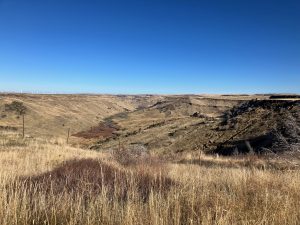
Finn and June get acquainted quickly, and just like that we are off. Several coveys of huns bail off the cliffs like chukars, sailing to the valley below. Finn points, and Jacob gets the first sharpie of the day. Mid morning the sun gains strength, even this late into October. The dogs slow down, but not before Finn scatters a big covey. We follow up. The dogs demand all the water, and we run out. One more detour leads to a long point by Finn. His body language shows the heat, there is no intensity, he just stopped walking. A pair of sharpies flushes a long way out, and I manage to bring one down. We’re done. Two sharpies and a hun each, and lots of more birds seen, it’s been a good morning.
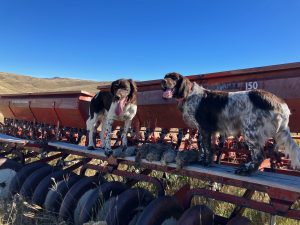
Later in the day we hunt cover for ruffed grouse. Finn finds a few, and I shoot one at the end of the walk, to reward him. We have a great meal of fresh birds, beans and corn. The couple of cold beers taste great too.
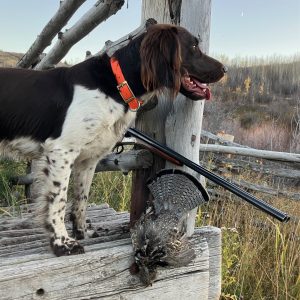
Day 4
Finn is limping, so he gets to sit this one out. June nicely works ahead of us, finds birds that Jacob hits, and I miss. Part of a covey flushes towards a saddle, and we follow-up. I get another chance that I squander, and a tight-holding bird in the saddle proves smarter than us, letting me pass within feet and flushing once I’ve passed. At the end of our loop, Jacob connects with the last bird to rise from a covey of huns. Another beautiful morning, in broken, mixed-vegetation terrain, with sage, grasses, occasional sunflower patches, and a few fields of something green. I try not to dwell on the misses.
We relocate to another cabin, an hour and a half North. Beautifully tucked into some trees, near a few large ponds, butting up against some hills at the end of the sage brush desert. The area is winter range for deer, elk and moose, but provides year-round habitat for sage, sharptailed grouse and huns. Where we had rocky ridges and deep valleys before, we’re now overlooking a seemingly endless relatively flat expanse of sage brush of varying density.
Towards dark we head out to walk the pond edges, to see if we can scare some ducks. Finn’s limping is mostly gone, with another good night’s sleep he will be running fit again in the morning. Small groups of ducks start flying, without giving us a real chance. The windless evening, setting sun combined with the yellowing reeds and mirror-like pond surface make for some great photo opportunities.
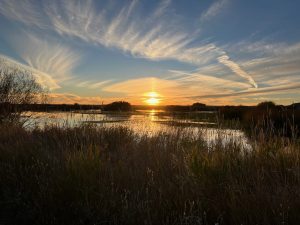
We sneak up to a small dam, and jump some ducks. Finn and June each retrieve one, but we may be missing a third. We see something move about three-quarters across the pond, a long swim. June goes first, calmly paddling across, making short detours left and right. She turns around not far from what we feel may be a wounded duck. Perhaps it isn’t a duck. Then Finn is up to bat, and takes the same leisurely approach, meandering across the pond, until he turns to go investigate what we hope is a bird. Whatever it is, he bumps it with his nose, and decides it’s not worth bringing. Fantastic swims by both dogs.
Day 5
Birds are scarce this morning. We stopped to take some pictures of a beautiful sunrise behind the Teton mountains. It’s June’s turn to rest up, and we hear her disapproving howls for a long time. A single sharpie flushed out of range early in our walk. Finn works hard, but it is just not a bird-filled morning. Another single sharpie flushes too close to Jacob, and finds his way into the vest.
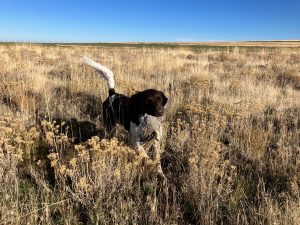
It’s one of those afternoons where the wind is chilled enough to make a sweater not a luxury, but the sun warm enough to make the dappled shade under a big aspen tree the perfect place to be. For a few uninterrupted hours I read, watch the robins congregate and get ready for their migration, and stare across the sage flats. I can’t remember when I last had such a calm afternoon, with nothing that needs doing, nothing to worry about, and nowhere to go. Just be. Drink a lemonade. Scratch Finn behind the ear.
Jacob’s wife shows up with their ten-month old son, and cooks us dinner. Taco soup, corn bread, a cold beer. I could get used to this life.
Day 6
On the drive to our last morning of hunting, we bust a covey of a three dozen sharpies that we watch sail across the sage, hoping they’ll settle. They don’t. We suppress the tendency to follow these birds on a two mile grunt through waste-high sage, and park further down the dirt road.
Both dogs are running today. As we are getting ready, I sense more than I hear something, across the road. Four big birds sort of levitate out of the green-grey bush, and slowly, silently take off across the flats. Sage grouse! We follow up, but we don’t find them. We cross the dirt road again, and hunt slightly more open country. June and Finn work well, the sun muted by a thin veil of cloud.
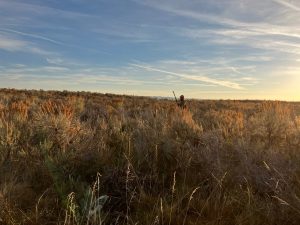
Jacob shows me a plant with tiny red seeds that we found in yesterday’s bird’s crop. My internal alarm goes off, I should check on Finn. I find him stationary, tail slowly wagging. Before I can act he takes a few sideways steps, stops again, and four more sage grouse flush. We messed up that opportunity. Sorry Finn.
Not much later we are angling back towards to truck, the wind not great. Finn pops up out of the sage to my left, and freezes. He nicely holds while Jacob moves closer. June runs in front of me, and I softly call her name. She freezes and turns her nose into the wind. Both dogs are steady until Jacob gets in range. Another four sage grouse rise, I guess sage grouse live in groups of four around here. Jacob shoots the biggest one, which turns out to be a sizeable mature male, retrieved by June. What a beautiful bird. And how modest they are. Hungarian partridge flush in utter chaos, each one picking a different direction. Sharpies laugh at you while they jump. A rooster makes enough ruckus to unsettle the calmest dog or gun. But sage grouse just materialize, and almost gentlemanly try to make a silent exit.
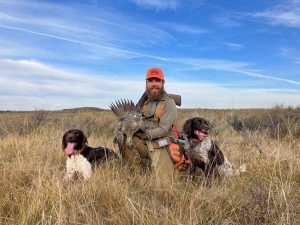
Later that morning Jacob manages to pick off the last of a group of three sage grouse, a younger male. We don’t find any more sharpies. The sun starts to burn, the cloud cover gone, and we call it a day. It’s time to pack up, and start the drive back to Canada.
Day 7
We hit the border before nine in the morning. One car ahead of me, definitely a record. The friendly Canadian border agent asks me the standard questions, throwing in a few about the hunt and the role of the dog. We get sent on our way quickly. A five-minute border crossing, this will never happen again. I think I have officially entered the category of travelers that is deemed harmless: older, traveling with a cute dog, friendly, and genuinely surprised when he gets asked about cannabis.
Snow starts falling as we continue North.
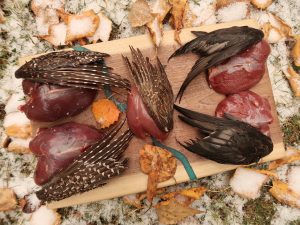
Day 8
The return to reality is harsh. The highway is covered with snow and ice and filled with commuters. Sitting in a conference hall with 700 people feels surreal. Flashbacks recur of a sunrise on the sage flats, dusty, rocky trails, running dogs, rising birds, and lazy afternoons.
I may have dozed off a time or two. The conference coffee lacks a punch. Jacob’s morning brew was better.
FD
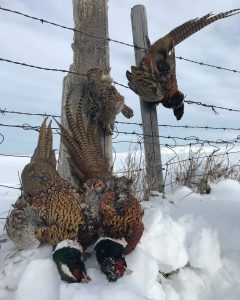
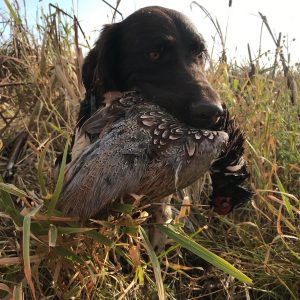
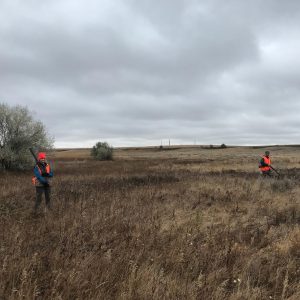
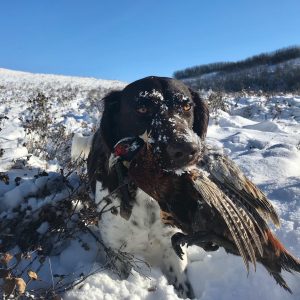
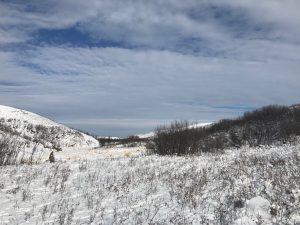
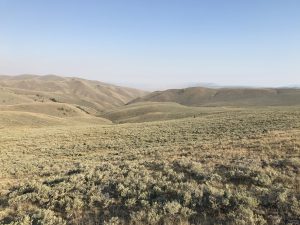
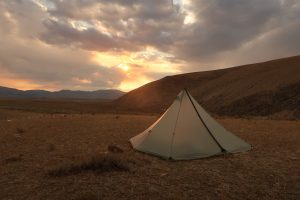
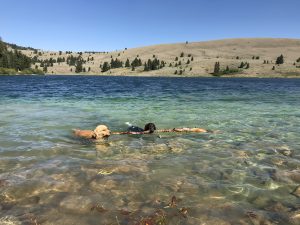 The choice of fields to hunt looked random to me, as for a mile in all directions the terrain was featureless, but it was based on years of experience in this area. I was beginning to pick up small clues about what sage grouse might like. Fresh greens, of which we saw little, grasshoppers, which were ubiquitous, just not in every field. Water perhaps? Some animals get their moisture from plants, but things were pretty arid here. I just imagined birds hitting up water early morning, working their way up to higher areas to catch a breeze, perhaps to return to water late afternoon, before retiring for the night in cover. But that was just speculation.
The choice of fields to hunt looked random to me, as for a mile in all directions the terrain was featureless, but it was based on years of experience in this area. I was beginning to pick up small clues about what sage grouse might like. Fresh greens, of which we saw little, grasshoppers, which were ubiquitous, just not in every field. Water perhaps? Some animals get their moisture from plants, but things were pretty arid here. I just imagined birds hitting up water early morning, working their way up to higher areas to catch a breeze, perhaps to return to water late afternoon, before retiring for the night in cover. But that was just speculation.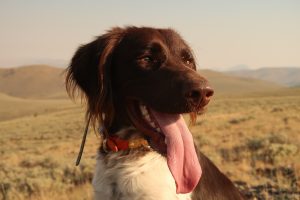
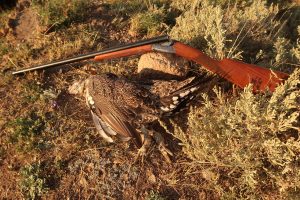 The second morning was mostly a repeat of the first. We hunted a large swath of land, in semi-circular fashion, above a small water source. My friend connected first, missing birds in a covey, but then connecting with the third shot on a single. Finn was bullied out of the retrieve by the other dog, but he got another chance. First a pair of grouse were bumped out of range by my friend’s dog, but not much later I shot a single with the second barrel, as it was rocketing down and around the slope. Finn nicely
The second morning was mostly a repeat of the first. We hunted a large swath of land, in semi-circular fashion, above a small water source. My friend connected first, missing birds in a covey, but then connecting with the third shot on a single. Finn was bullied out of the retrieve by the other dog, but he got another chance. First a pair of grouse were bumped out of range by my friend’s dog, but not much later I shot a single with the second barrel, as it was rocketing down and around the slope. Finn nicely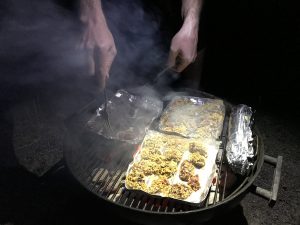 At night, my friend’s son cooked us up a nice meal of cubed, breaded grouse breast, and cutthroat trout. A few cold beers went with that, and life could not have been much better.
At night, my friend’s son cooked us up a nice meal of cubed, breaded grouse breast, and cutthroat trout. A few cold beers went with that, and life could not have been much better.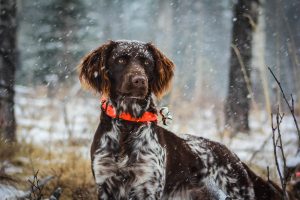 Tanner and Toby are very personable individuals, who make you feel welcome from the get go, and who go to great lengths to show off their dogs and provide you with all the info you need to make a decision on whether a Small Munsterlander is for you.
Tanner and Toby are very personable individuals, who make you feel welcome from the get go, and who go to great lengths to show off their dogs and provide you with all the info you need to make a decision on whether a Small Munsterlander is for you.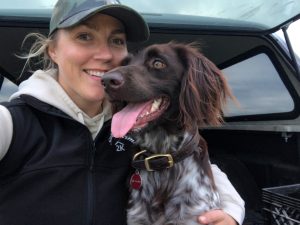
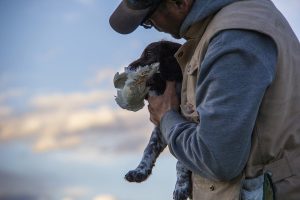 Not being a person that makes decisions on the fly, with a desire to control all parameters that borders on the unhealthy, I struggled a lot through the process of selecting a pup, or rather selecting three. When the sorting was all done, and all the pups had traveled home with their new owners, I asked Tanner and Toby to put some words to paper about the history of their kennel, their breeding program and more specifically how they deal with the process of matching pups to owners.
Not being a person that makes decisions on the fly, with a desire to control all parameters that borders on the unhealthy, I struggled a lot through the process of selecting a pup, or rather selecting three. When the sorting was all done, and all the pups had traveled home with their new owners, I asked Tanner and Toby to put some words to paper about the history of their kennel, their breeding program and more specifically how they deal with the process of matching pups to owners.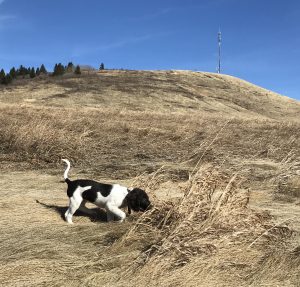
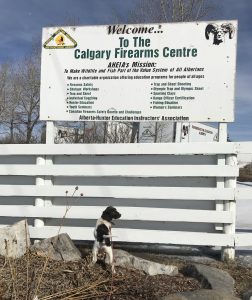
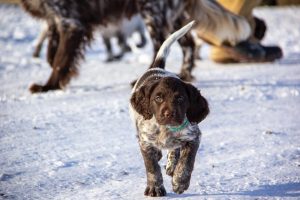
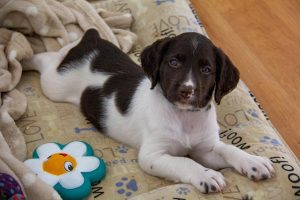
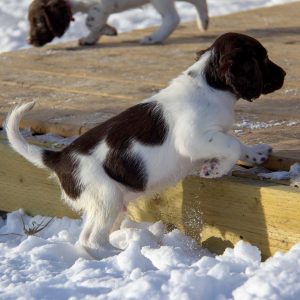
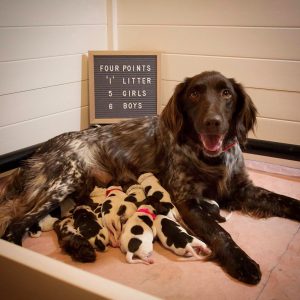 Until then we are just enjoying the photos and videos that Tanner and Toby put up on Instagram and Facebook. Go have a look: @fourpointkennels. They have another litter coming soon, so the next two months their feed will be full of adorable pups.
Until then we are just enjoying the photos and videos that Tanner and Toby put up on Instagram and Facebook. Go have a look: @fourpointkennels. They have another litter coming soon, so the next two months their feed will be full of adorable pups.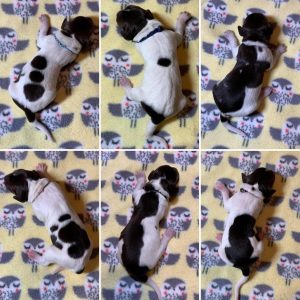
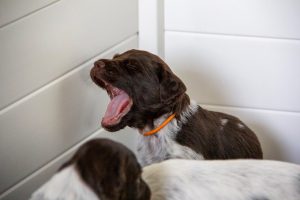
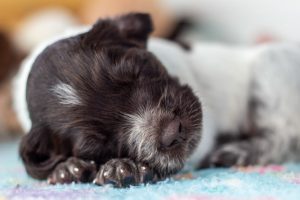 Cuteness overload
Cuteness overload 